Charles E W Bean, Diaries, AWM38 3DRL 606/237/1 - October 1914 - 1918 - Part 13
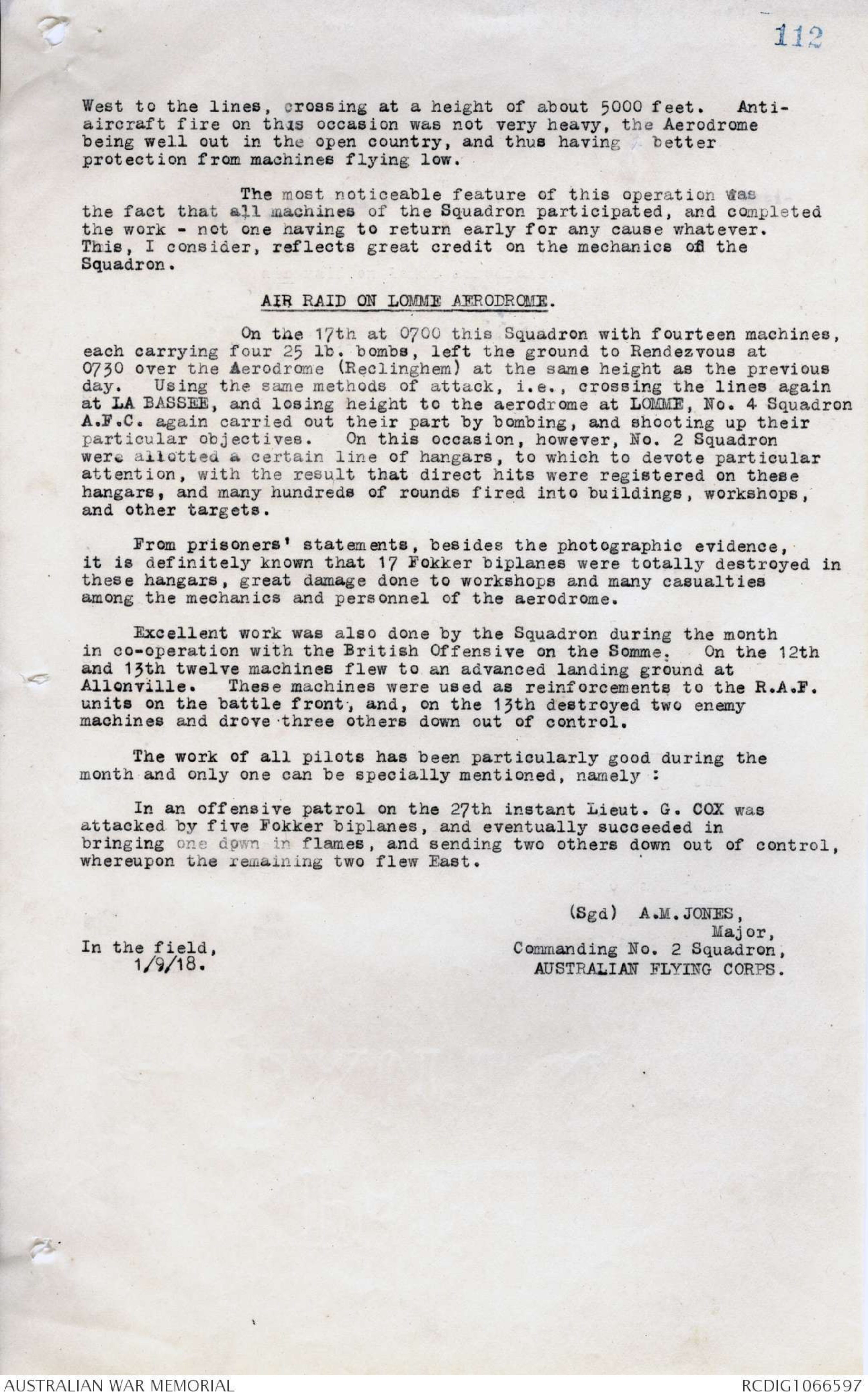
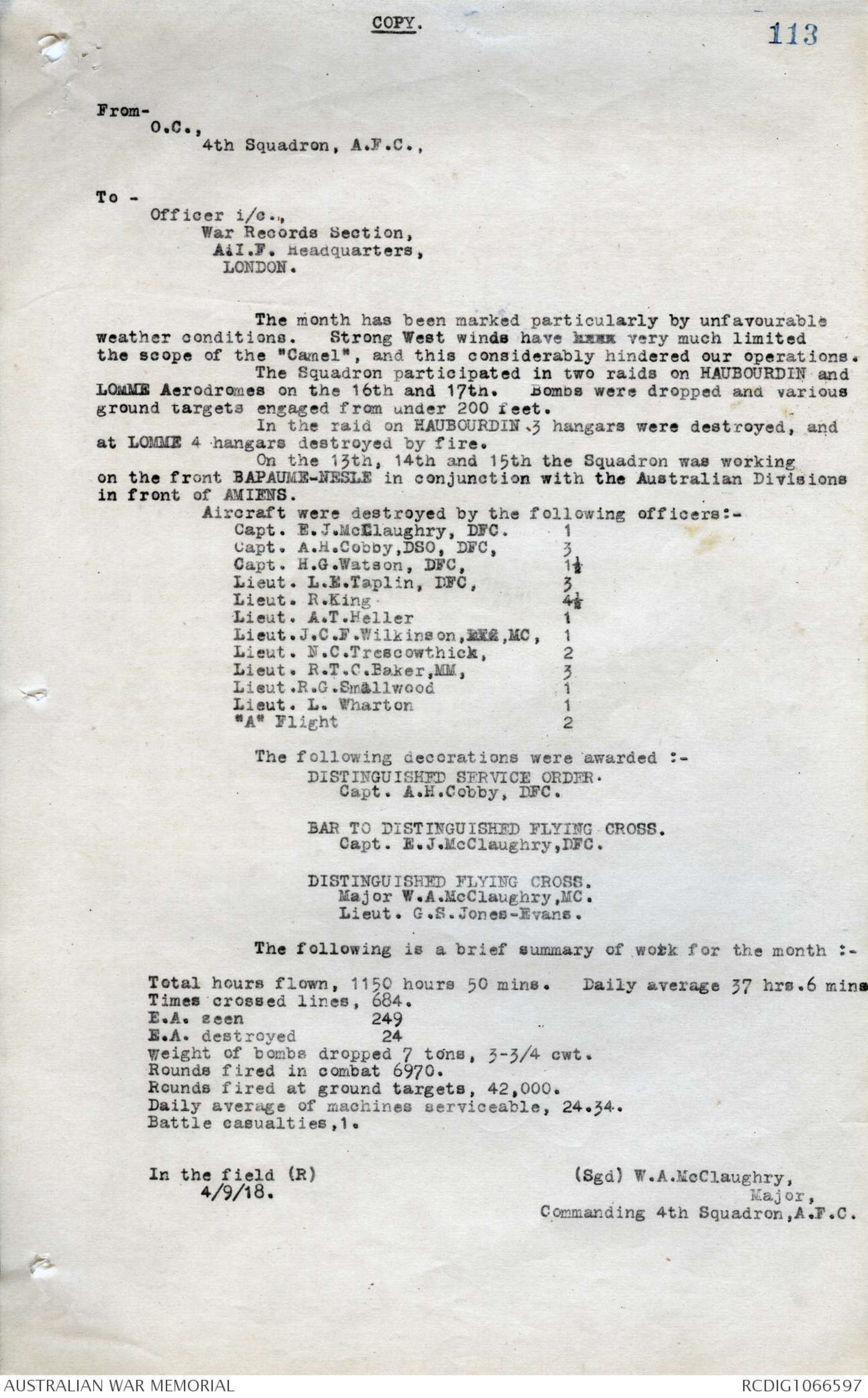
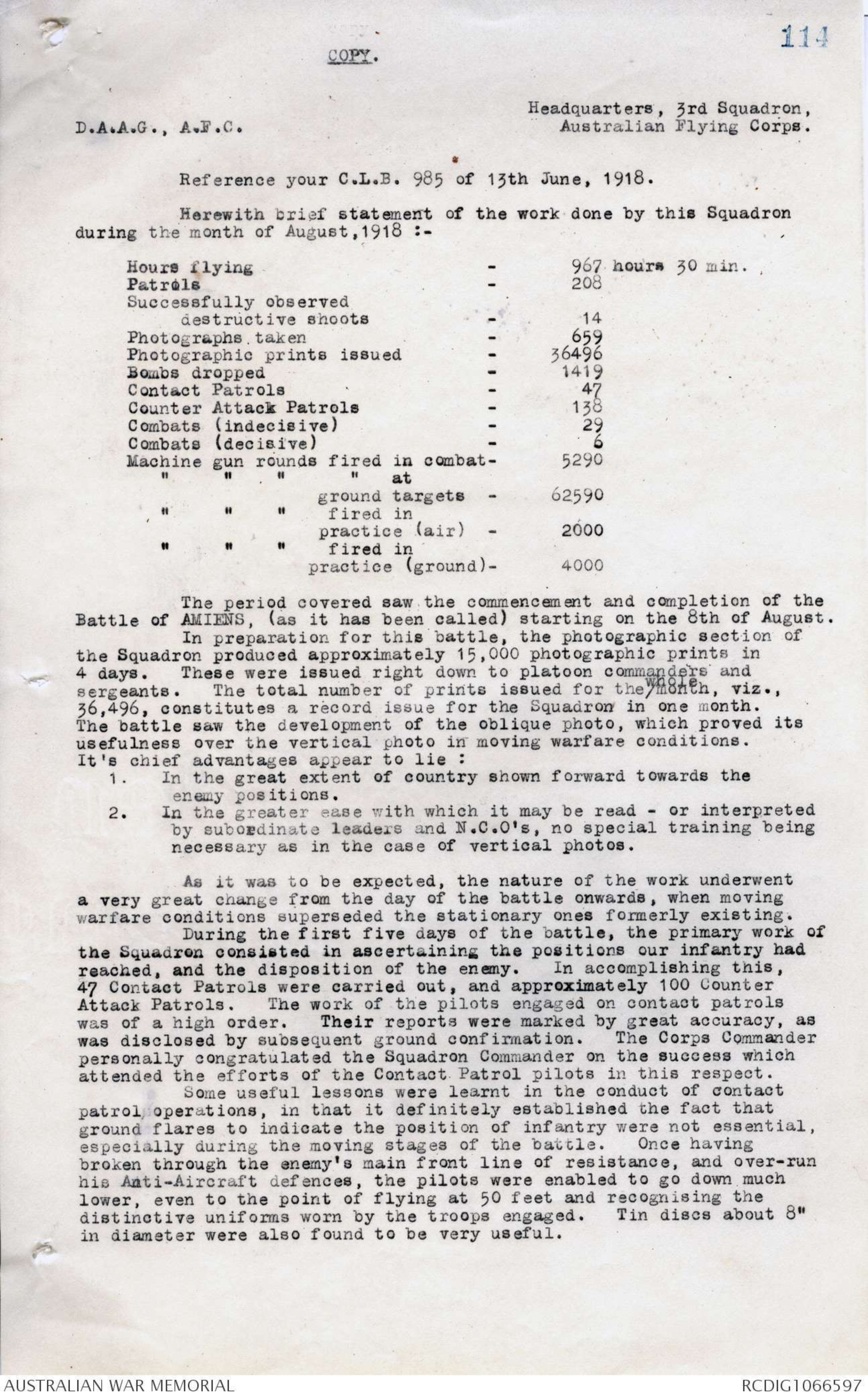
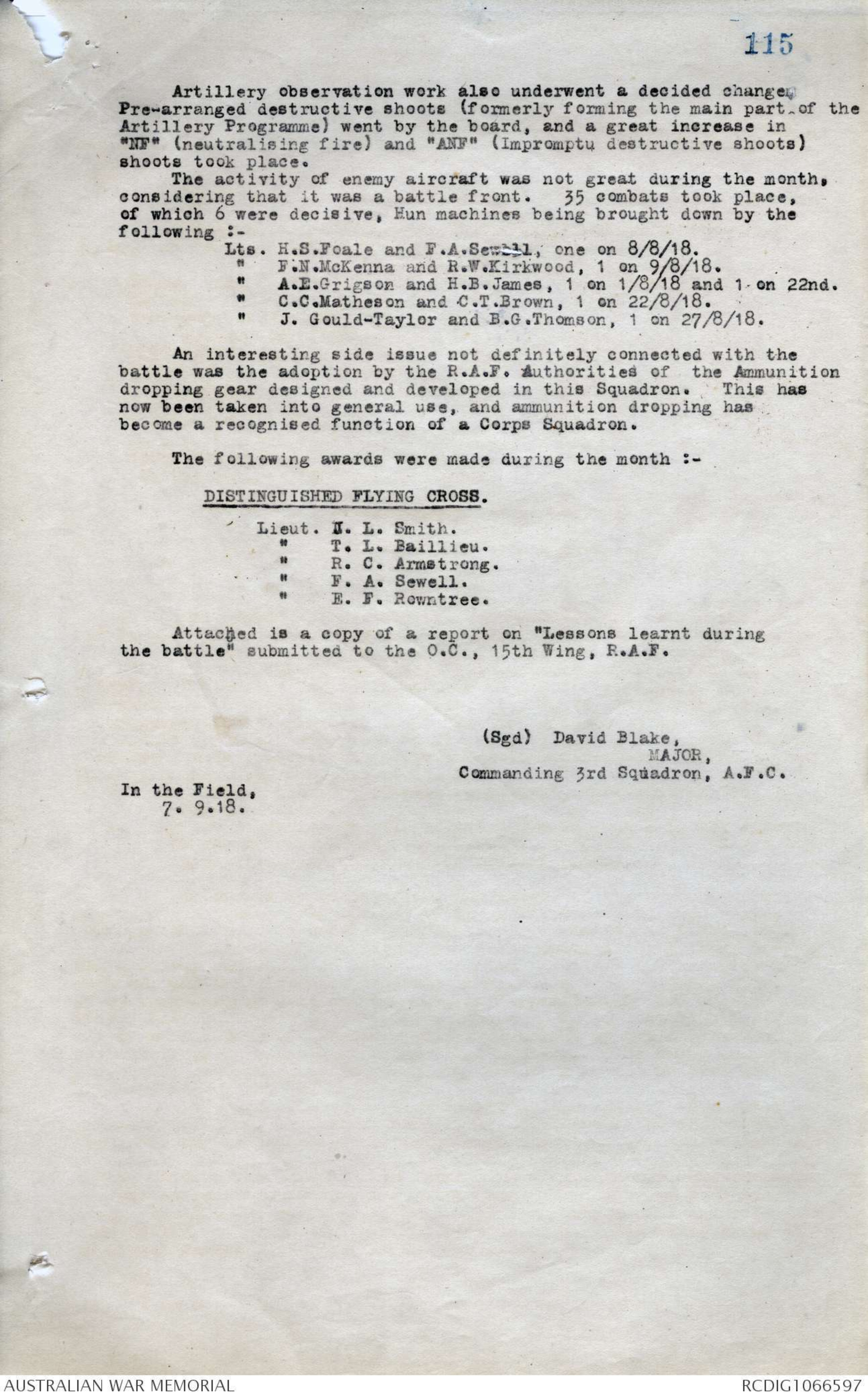
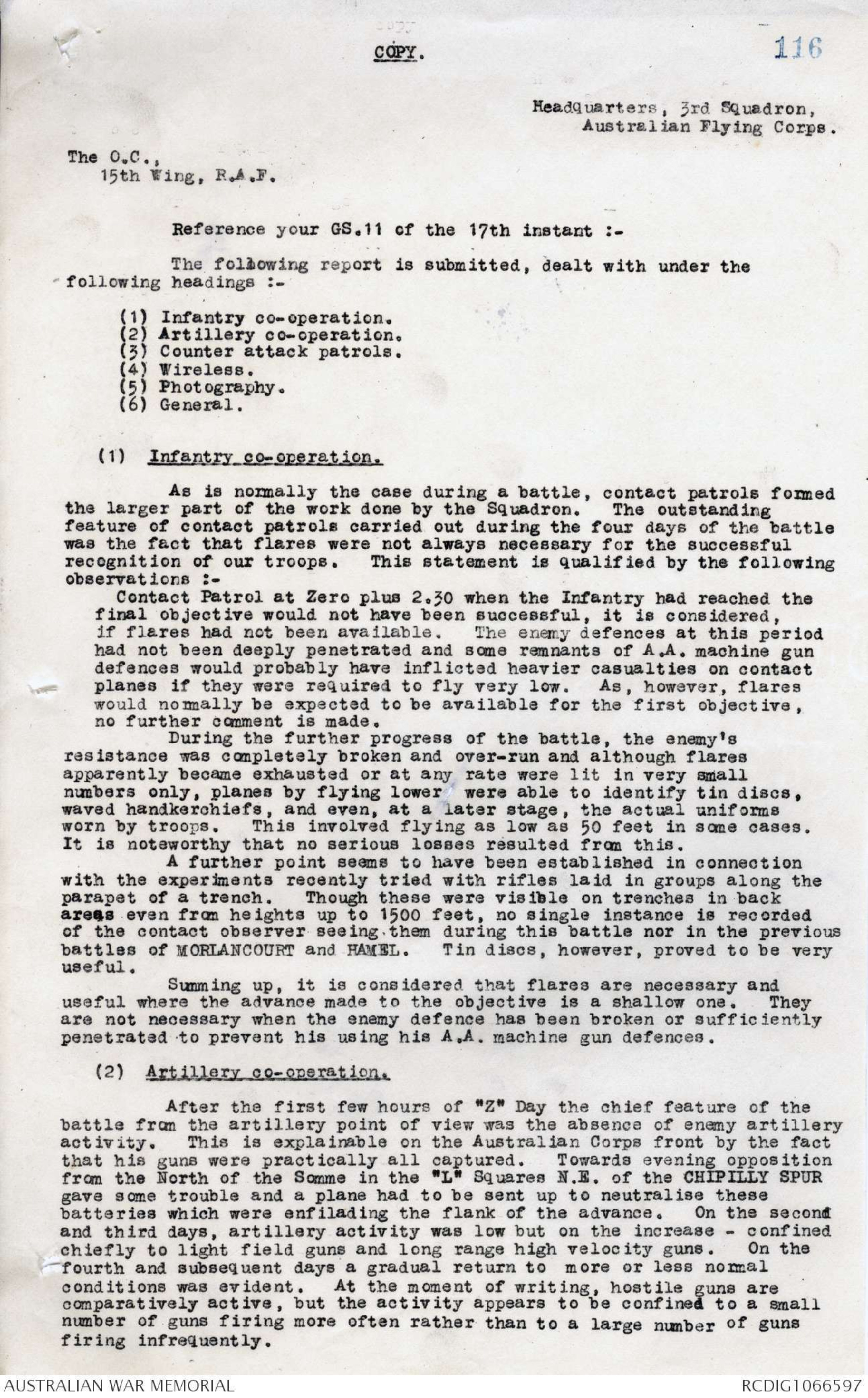
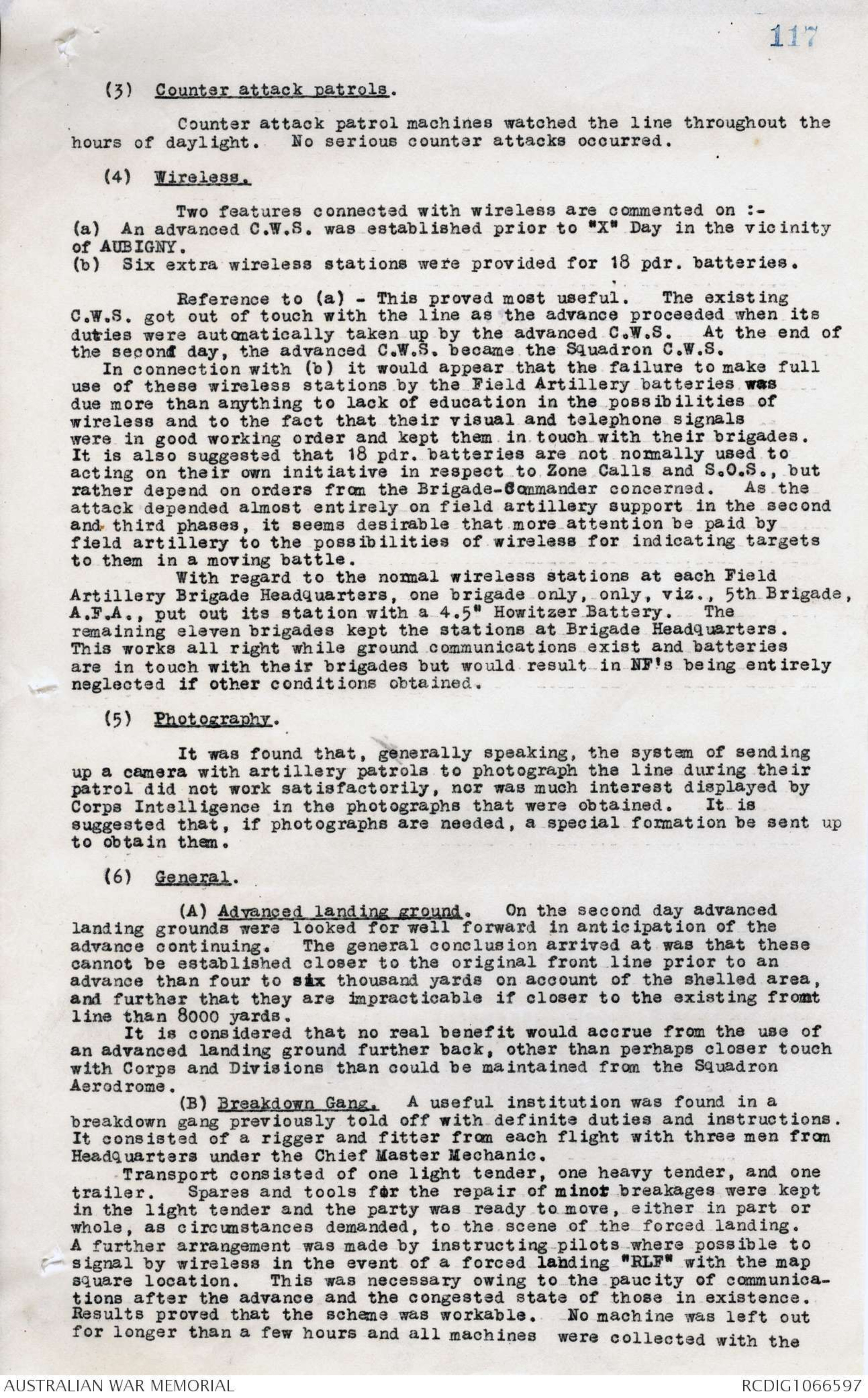
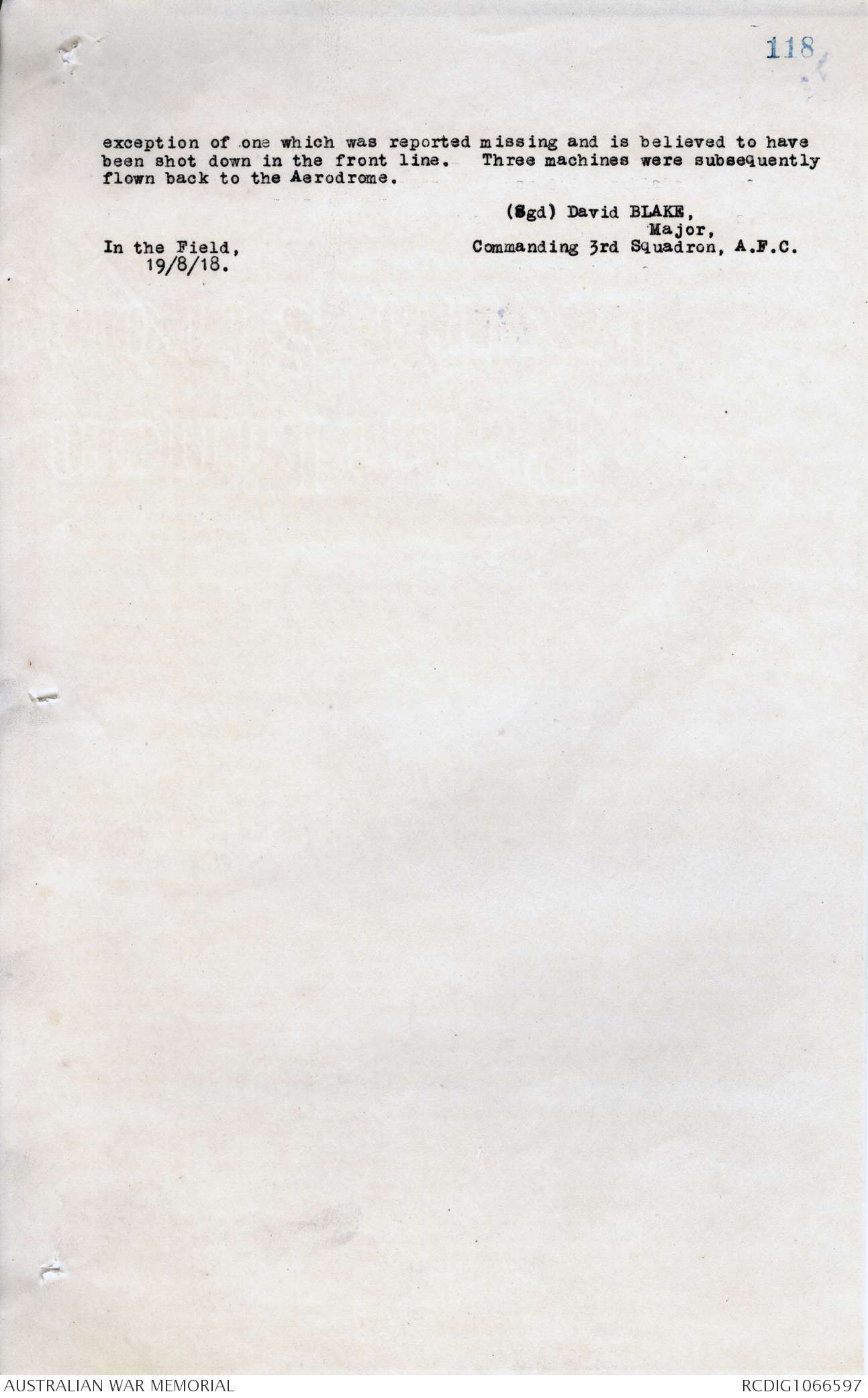
112
West to the lines, crossing at a height of about 5000 feet. Anti-aircraft
fire on this occasion was not very heavy, the Aerodrome
being well out in the open country, and thus having better
protection from machines flying low.
The most noticeable feature of this operation was
the fact that all machines of the Squadron participated, and completed
the work - not one having to return early for any cause whatever.
This, I consider, reflects great credit on the mechanics of the
Squadron.
AIR RAID ON LOMME AFRODROME.
On the 17th at 0700 this Squadron with fourteen machines,
each carrying four 25 lb. bombs, left the ground to Rendezvous at
0730 over the Aerodrome (Reclinghem) at the same height as the previous
day. Using the same methods of attack, i.e., crossing the lines again
at LA BASSEE, and losing height to the aerodrome at LOMME, No. 4 Squadron
A.F.C. again carried out their part by bombing, and shooting up their
particular objectives. On this occasion, however, No. 2 Squadron
were allotted a certain line of hangars, to which to devote particular
attention, with the result that direct hits were registered on these
hangars, and many hundreds of rounds fired into buildings, workshops,
and other targets.
From prisoners' statements, besides the photographic evidence
it is definitely known that 17 Fokker biplanes were totally destroyed in
these hangars, great damage done to workshops and many casualties
among the mechanics and personnel of the aerodrome.
Excellent work was also done by the Squadron during the month
in co-operation with the British Offensive on the Somme. On the 12th
and 13th twelve machines flew to an advanced landing ground at
Allonville. These machines were used as reinforcements to the R.A.F.
units on the battle front, and, on the 13th destroyed two enemy
machines and drove three others down out of control.
The work of all pilots has been particularly good during the
month and only one can be specially mentioned, namely :
In an offensive patrol on the 27th instant Lieut. G. COX was
attacked by five Fokker biplanes, and eventually succeeded in
bringing one down in flames, and sending two others down out of control,
whereupon the remaining two flew East.
(Sgd) A.M. JONES
Major.
Commanding No. 2 Squadron
AUSTRALIAN FLYING CORPS.
In the field,
1/9/18.
COPY.
113
From-
O.C.,
4th Squadron, A.F.C.,
To -
Officer i/c.,
War Records Section,
A.l.F. Headquarters,
LONDON.
The month has been marked particularly by unfavourable
weather conditions. Strong West winds have xxxx very much limited
the scope of the "Camel", and this considerably hindered our operations.
The Squadron participated in two raids on HAUBOURDIN and
LOMME Aerodromes on the 16th and 17th. Bombs were dropped and various
ground targets engaged from under 200 feet.
In the raid on HAUBOURDIN 3 hangars were destroyed, and
at LOMME 4 hangars destroyed by fire.
On the 13th, 14th and 15th the Squadron was working
on the front BAPAUME-NESLE in conjunction with the Australian Divisions
in front of AMIENS.
Aircraft were destroyed by the following officers:-
Capt. E.J.McClaughry, DFC. 1
Capt. A.H.Cobby, DSO, DFC. 3
Capt. H.G.Watson, DFC 1½
Lieut. L.E.Taplin, DFC, 3
Lieut. R.King 4½
Lieut. A.T. Heller 1
Lieut.J.C.F.Wilkinson, xxx,MC 1
Lieut. N.C.Trescowthick, 2
Lieut. R.T.C.Baker,MM, 3
Lieut.R.G.Smallwood 1
Lieut. L. Wharton 1
"A" Flight 2
The following decorations were awarded :-
DISTINGUISHED SERVICE ORDER.
Capt. A.H.Cobby, DFC.
BAR TO DISTINGUISHFD FLYING CROSS.
Capt. E.J.McClaughry, DFC.
DISTINGUISHED FLYING CROSS
Major W.A.McClaughry, MC.
Lieut. G.S. Jones-Evans.
The following is a brief summary of work for the month :
Total hours flown, 1150 hours 50 mins. Daily average 37 hrs.6 mins
Times crossed lines, 684.
E.A. seen 249
E.A. destroyed 24
Weight of bombs dropped 7 tons, 3-3/4 cwt.
Rounds fired in combat 6970.
Rounds fired at ground targets, 42,000.
Daily average of machines serviceable, 24.34.
Battle casualties,1.
In the field (R)
4/9/18.
(Sgd) W.A.McClaughry,
Major
Commanding 4th Squadron, A.F.C.
114.
COPY.
Headquarters, 3rd Squadron,
D.A.A.G., A.F.C. Australian Flying Corps.
Reference your C.L.B. 985 of 13th June, 1918.
Herewith brief statement of the work done by this Squadron
during the month of August, 1918 :-
Hours flying - 967 hour 30 min.
Patrols - 208
Successfully observed
destructive shoots - 14
Photographs taken - 659
Photographic prints issued - 36496
Bombs dropped - 1419
Contact Patrols - 47
Counter Attack Patrols - 138
Combats (indecisive) - 29
Combats (decisive) - 6
Machine gun rounds fired in combat- 5290
" " " at
ground targets - 62590
" " " fired in
practice (air) 2000
" " " fired in
practice (ground)- 4000
The period covered saw the commencement and completion of the
Battle of AMIENS, (as it has been called) starting on the 8th of August.
In preparation for this battle, the photographic section of
the Squadron produced approximately 15,000 photographic prints in
4 days. These were issued right down to platoon commanders and
sergeants. The total number of prints issued for the ^whole month, viz.
36,496, constitutes a record issue for the Squadron in one month.
The battle saw the development of the oblique photo, which proved its
usefulness over the vertical photo in moving warfare conditions.
It's chief advantages appear to lie :
1. In the great extent of country shown forward towards the
enemy positions.
2. In the greater ease with which it may be read - or interpreted
by subordinate leaders and N.C.O's, no special training being
necessary as in the case of vertical photos.
As it was to be expected, the nature of the work underwent
a very great change from the day of the battle onwards, when moving
warfare conditions superseded the stationary ones formerly existing.
During the first five days of the battle, the primary work of
the Squadron consisted in ascertaining the positions our infantry had
reached, and the disposition of the enemy. In accomplishing this
47 Contact Patrols were carried out, and approximately 100 Counter
Attack Patrols. The work of the pilots engaged on contact patrols
was of a high order. Their reports were marked by great accuracy, as
was disclosed by subsequent ground confirmation. The Corps Commander
personally congratulated the Squadron Commander on the success which
attended the efforts of the Contact Patrol pilots in this respect.
Some useful lessons were learnt in the conduct of contact
patrol operations, in that it definitely established the fact that
ground flares to indicate the position of infantry were not essential,
especially during the moving stages of the battle. Once having
broken through the enemy's main front line of resistance, and over-run
his Anti-Aircraft defences, the pilots were enabled to go down much
lower, even to the point of flying at 50 feet and recognising the
distinctive uniforms worn by the troops engaged. Tin discs about 8"
in diameter were also found to be very useful.
115
Artillery observation work also underwent a decided change.
Pre-arranged destructive shoots (formerly forming the main part of the
Artillery Programme) went by the board, and a great increase in
"NF" (neutralising fire) and "ANF" (Impromptu destructive shoots)
shoots took place.
The activity of enemy aircraft was not great during the month,
considering that it was a battle front. 35 combats took place,
of which 6 were decisive, Hun machines being brought down by the
following:-
Lts. H.S.Foale and F.A.Sewell, one on 8/8/18.
" F.N.McKenna and R.W.Kirkwood, 1 on 9/8/18.
" A.E.Grigson and H.B. James, 1 on 1/8/18 and 1 on 22nd.
" C.C.Matheson and C.T.Brown, 1 on 22/8/18.
" J. Gould-Taylor and B.G.Thomson, 1 on 27/8/18.
An interesting side issue not definitely connected with the
battle was the adoption by the R.A.F. Authorities of the Ammunition
dropping gear designed and developed in this Squadron. This has
now been taken into general use, and ammunition dropping has
become a recognised function of a Corps Squadron.
The following awards were made during the month:-
DISTINGUISHED FLYING CROSS.
Lieut. I. L. Smith.
" T. L. Baillieu.
" R. C. Armstrong.
" F. A. Sewell.
" E. F. Rowntree.
Attached is a copy of a report on "Lessons learnt during
the battle" submitted to the O.C., 15th Wing, R.A.F.
(Sgd) David Blake,
MAJOR
Commanding 3rd Squadron, A.F.C.
In the Field,
7. 9.18.
116
COPY.
Headquarters, 3rd Squadron,
Australian Flying Corps.
The O.C.
15th Wing, R.A.F.
Reference your GS.11 of the 17th instant:-
The following report is submitted, dealt with under the
following headings :
(1) Infantry co-operation.
(2) Artillery co-operation.
3) Counter attack patrols.
(4) Wireless.
(5) Photography.
(6) General.
(1) Infantry co-operation.
As is normally the case during a battle, contact patrols formed
the larger part of the work done by the Squadron. The outstanding
feature of contact patrols carried out during the four days of the battle
was the fact that flares were not always necessary for the successful
recognition of our troops. This statement is qualified by the following
observations :-
Contact Patrol at Zero plus 2.30 when the Infantry had reached the
final objective would not have been successful, it is considered
if flares had not been available. The enemy defences at this period
had not been deeply penetrated and some remnants of A.A. machine gun
defences would probably have inflicted heavier casualties on contact
planes if they were required to fly very low. As, however, flares
would normally be expected to be available for the first objective,
no further comment is made.
During the further progress of the battle, the enemy's
resistance was completely broken and over-run and although flares
apparently became exhausted or at any rate were lit in very small
numbers only, planes by flying lower were able to identify tin discs
waved handkerchiefs, and even, at a later stage, the actual uniforms
worn by troops. This involved flying as low as 50 feet in some cases.
It is noteworthy that no serious losses resulted from this.
A further point seems to have been established in connection
with the experiments recently tried with rifles laid in groups along the
parapet of a trench. Though these were visible on trenches in back
areas even from heights up to 1500 feet, no single instance is recorded
of the contact observer seeing them during this battle nor in the previous
battles of MORLANCOURT and HAMEL. Tin discs, however, proved to be very
useful.
Summing up, it is considered that flares are necessary and
useful where the advance made to the objective is a shallow one. They
are not necessary when the enemy defence has been broken or sufficiently
penetrated to prevent his using his A.A. machine gun defences.
(2) Artillery co-operation.
After the first few hours of "Z" Day the chief feature of the
battle from the artillery point of view was the absence of enemy artillery
activity. This is explainable on the Australian Corps front by the fact
that his guns were practically all captured. Towards evening opposition
from the North of the Somme in the "L" Squares N.E. of the CHIPILLY SPUR
gave some trouble and a plane had to be sent up to neutralise these
batteries which were enfilading the flank of the advance. On the second
and third days, artillery activity was low but on the increase - confined
chiefly to light field guns and long range high velocity guns. On the
fourth and subsequent days a gradual return to more or less normal
conditions was evident. At the moment of writing, hostile guns are
comparatively active, but the activity appears to be confined to a small
number of guns firing more often rather than to a large number of guns
firing infrequently.
117
(3) Counter attack patrols.
Counter attack patrol machines watched the line throughout the
hours of daylight. No serious counter attacks occurred.
(4) Wireless.
Two features connected with wireless are commented on : -
(a) An advanced C.W.S. was established prior to "X" Day in the vicinity
of AUBIGNY
(b) Six extra wireless stations were provided for 18 pdr. batteries.
Reference to (a) - This proved most useful. The existing
C.W.S. got out of touch with the line as the advance proceeded when its
duties were automatically taken up by the advanced C.W.S. At the end of
the second day, the advanced C.W.S. became the Squadron C.W.S.
In connection with (b) it would appear that the failure to make full
use of these wireless stations by the Field Artillery batteries was
due more than anything to lack of education in the possibilities of
wireless and to the fact that their visual and telephone signals
were in good working order and kept them in touch with their brigades.
It is also suggested that 18 pdr. batteries are not normally used to
acting on their own initiative in respect to. Zone Calls and S.O.S., but
rather depend on orders from the Brigade-Commander concerned. As the
attack depended almost entirely on field artillery support in the second
and third phases, it seems desirable that more attention be paid by
field artillery to the possibilities of wireless for indicating targets
to them in a moving battle.
With regard to the normal wireless stations at each Field
Artillery Brigade Headquarters, one brigade only, only, viz., 5th Brigade,
A.F.A., put out its station with a 4.5" Howitzer Battery. The
remaining eleven brigades kept the stations at Brigade Headquarters.
This works all right while ground communications exist and batteries
are in touch with their brigades but would result in NF's being entirely
neglected if other conditions obtained.
(5) Photography.
It was found that, generally speaking, the system of sending
up a camera with artillery patrols to photograph the line during their
patrol did not work satisfactorily, nor was much interest displayed by
Corps Intelligence in the photographs that were obtained. It is
suggested that, if photographs are needed, a special formation be sent up
to obtain then.
(6) General.
(A) Advanced landing ground. On the second day advanced
landing grounds were looked for well forward in anticipation of the
advance continuing. The general conclusion arrived at was that these
cannot be established closer to the original front line prior to an
advance than four to six thousand yards on account of the shelled area
and further that they are impracticable if closer to the existing front
line than 8000 yards.
It is considered that no real benefit would accrue from the use of
an advanced landing ground further back, other than perhaps closer touch
with Corps and Divisions than could be maintained from the Squadron
Aerodrome.
(B) Breakdown Gang. A useful institution was found in a
breakdown gang previously told off with definite duties and instructions
It consisted of a rigger and fitter from each flight with three men from
Headquarters under the Chief Master Mechanic.
Transport consisted of one light tender, one heavy tender, and one
trailer. Spares and tools for the repair of minor breakages were kept
in the light tender and the party was ready to move, either in part or
whole, as circumstances demanded, to the scene of the forced landing.
A further arrangement was made by instructing pilots where possible to
signal by wireless in the event of a forced landing "RLF" with the map
square location. This was necessary owing to the paucity of communications
tions after the advance and the congested state of those in existence.
Results proved that the scheme was workable. No machine was left out
for longer than a few hours and all machines were collected with the
118
exception of one which was reported missing and is believed to have
been shot down in the front line. Three machines were subsequently
flown back to the Aerodrome.
(sgd) David BLAKE
Major,
Commanding 3rd Squadron, A.F.C.
In the Field
19/8/18.
 H.Boutell
H.BoutellThis transcription item is now locked to you for editing. To release the lock either Save your changes or Cancel.
This lock will be automatically released after 60 minutes of inactivity.